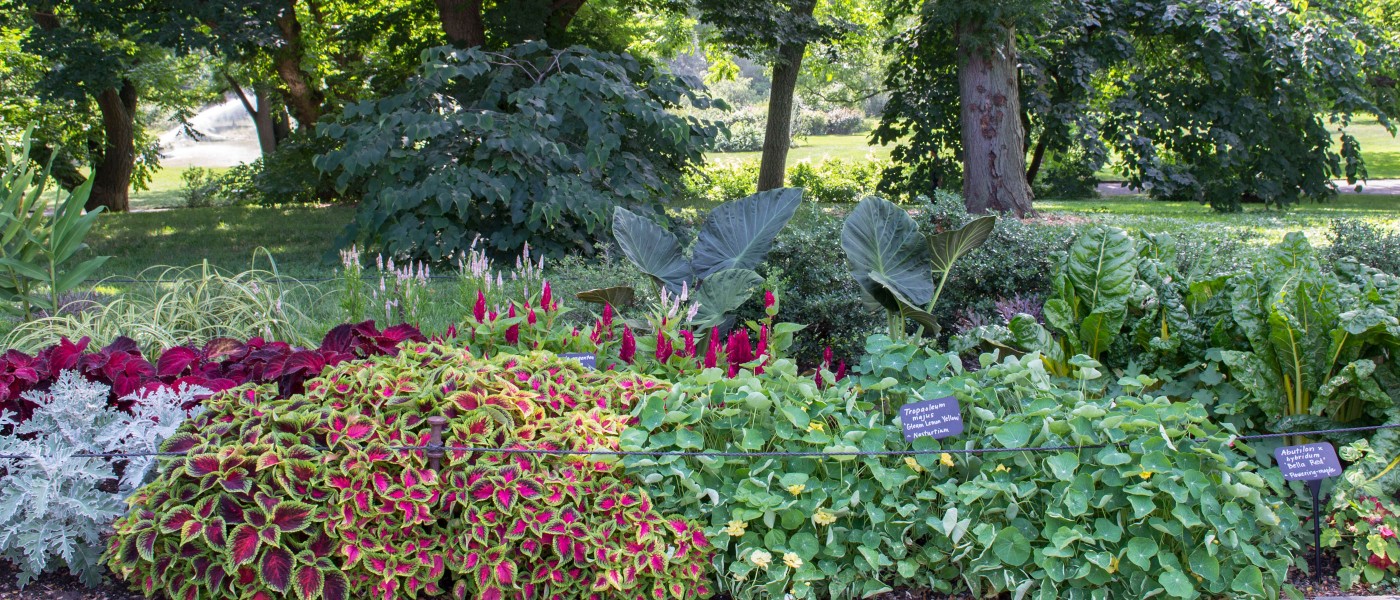Annual Border: The Right Plants for Your Microclimate
One of the reasons gardening in the city can be tough: microclimates. A hot, sunny roof without access to irrigation is quite a different place from a low-lying shady corner on the north side of a building, though they are both in USDA Plant Hardiness Zone 6b. Even within a small yard, you might have wide variations in sun exposure and soil moisture.
This summer, the Annual Border showcases its own various "microclimates," so for this design, the border dictated the plants. Whether the conditions from one end of the border to the other were full sun or partial shade, dry or moist, I tried to choose just the right plant. Each section offers a stylistic counterpoint to the others, inspired by the climate—from tropical to subtropical to temperate—that best represents it.
So when you visit the Annual Border throughout the summer, enjoy it for its beauty, but also consider the plant choices for your own garden's microclimates. Luckily, there is an amazing array of annuals available. By choosing either plants that are suited to your specific site or ones that are tolerant of a range of conditions, you can avoid fighting your garden site too much. Of course, one of the beauties of gardening is that you can try new things, so it’s okay to choose a few plants as trials, as I did.
Read on for more details about the conditions and plants included.
Full Sun + Dry Soil
Full sun generally means direct sunlight all day, or a minimum of six hours of direct sunlight.
Soils may be inherently dry because of their composition and structure (rocky, sandy, porous, well draining) or dry due to circumstance (exposure to sun, heat, drought). The section of the border that represents these conditions therefore contains a selection of full-sun, drought-tolerant plants.
Lantana (Lantana camara ‘Bandana Pink’), purple heart spiderwort (Tradescantia pallida ‘Purpurea’), and treasure flower (Gazania rigens ‘Talent Rose Shades’) can all handle such conditions, but they are tough in general and can also handle moister and shadier conditions.
Desert marigold (Baileya multiradiata), moss rose (Portulaca grandiflora ‘Happy Trails White’) and blue-eyed daisy (Arctotis grandis), on the other hand, need full sun but thrive on leaner, well-drained soils. The plants in this section don’t want a lot of water, and that’s just fine with me. My main concern is how some of them will react to our humid summers.
Full Sun + Average Soil Moisture
This section of the border gets full sun and what we’re calling average soil moisture. The soil here is pretty close to a straight loam—a balanced proportion of sand, silt, clay, and organic matter. It can retain moisture and yet drain sufficiently to provide air to growing roots.
This is arguably the ideal condition for gardening with annuals. The plant palette in our region is wide and varied. Many of the selections are tried and true and make it through our hot, humid summers while providing color and texture until frost. Examples: butter daisy (Melampodium divaricatum ‘Showstar’), globe amaranth (Gomphrena globosa ‘Bicolor Rose’), floss flower (Ageratum houstonianum ‘Florist Blue’), cardoon (Cynara cardunculus), dusty miller (Jacobaea maritima ‘Candicans’).
Full Shade + Moist Soil
Full shade generally means less than three hours of direct sunlight.
Moist soils are those that are continually damp. This can occur because the soil has a high clay content or because it sits in a low-lying area where runoff collects and/or is in a protected site where evapotranspiration is at a minimum.
Moist conditions make me think tropical. Tropical perennials are often used as annuals in our region since they can't survive our winters. They provide a characteristic lush look and offer a variety of forms and textures. I chose some specimen plants to serve as focal points, along with some textural fillers, including elephant ear cultivars (Alocasia ‘Regal Shields’ and ‘Portodoro’) Skullcap (Scutellaria javanica ‘Veranda’), polka dot plant (Hypoestes phyllostachya ‘Splash Select Red’,) and coleus (Plectranthus scutellarioides ‘Giant Exhibition Multicolor’.
Partial Sun + Average Soil Moisture
These plants need between three and six hours of sunlight per day.
There are two sections within the border that get partial sun with average soil moisture. I used this opportunity to explore two different styles. One section features more tropical plants—for example, another elephant ear cultivar (Colocasia gigantea ‘Thailand Giant’), popcorn cassia (Senna didymobotrya), downy thorn apple (Datura metel ‘Blanche Belle’), and tropical hibiscus (Hibiscus rosa-sinensis ‘El Toro’).
The other section is a selection of temperate plants that are more commonly used as annuals in our region, like flowering tobacco (Nicotiana mutabilis ‘Marshmallow’), toothache plant (Spilanthes oleracea ‘Lemon Drop’), zonal geranium (Pelargonium x hortorum ‘Maverick Salmon’), and Brazilian button flower (Centratherum intermedium ‘Pineapple Sangria’).
Partial Shade + Dry Soils
These plants also need between three and six hours of sunlight but prefer those hours to be in the morning, with protective shade in the afternoon.
This section also has dry soils because an adjacent locust tree takes up most of the water within its drip line (which encroaches on the border). The tree also shades the area in the afternoon, making this a very challenging section. Rather than select plants that would compete with the locust tree for resources, I chose plants that are tolerant of drought and partial shade: Bolivian begonia (Begonia boliviensis ‘Bonfire’), jewels of Opar (Talinum paniculatum ‘Verde’), clasping coneflower (Dracopis amplexicaulis), and calico plant (Alternanthera dentata ‘Rubiginosa’).
Partial Shade + Moist Soils
The southernmost section of the border is part sun/part shade with relatively moist soils. Once again, I went with tropical choices that work with the moist soils: leea (Leea amabilis var. splendens), ginger lily (Hedychium gardernianum 'Tara'), wheatstraw celosia (Celosia argentea var. cristata ‘Flamingo Feather’), and flowering maple (Abutilon x hybridum ‘Bella Red’).


